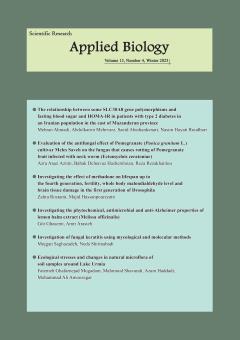Investigating antibiotic resistance and biofilm formation potential of Pseudomonas aeruginosa isolates isolated from Kerman hospitals
Subject Areas : microbiology
Umm Al-Banin Habili
1
![]() ,
Farokh Rokhbakhsh
2
,
Farokh Rokhbakhsh
2
![]()
1 - Department of Microbiology, Kerman Branch, Islamic Azad University, Kerman, Iran
2 - Department of Microbiology, Kerman Branch, Islamic Azad University, Kerman, Iran
Keywords: Antibiotic resistance, Biofilm, Pseudomonas aeruginosa isolates, Kerman hospitals.,
Abstract :
Purpose: Pseudomonas aeruginosa is one of the causes of acquired secondary infections. This bacterium causes hospital infections, including surgical wounds, burns, and chronic lung infections. In this regard, the present study was conducted with the aim of investigating the antibiotic resistance and biofilm formation potential of Pseudomonas aeruginosa strains isolated from Kerman hospitals.
Materials and methods: This descriptive cross-sectional study was conducted on 70 hospital clinical samples. First, biochemical tests were performed on the samples in order to isolate and confirm the genus Pseudomonas aeruginosa. Antibiotic resistance pattern of strains was determined by disk diffusion method for 11 antibiotics. Then, the ability of biofilm formation in these strains was evaluated.
Findings: 29 Pseudomonas aeruginosa isolates were isolated from 70 hospital clinical samples by biochemical tests, of which 16 Pseudomonas aeruginosa strains were biofilm producers. The highest antibiotic resistance in the antibiotic resistance test is related to imipenem (17.24%), meropenem (58.27%), cefotaxime (62.06%), aztronam (75.86%), tobramycin (27.2%), respectively. 48%), cefpinem (41.37%), ciprofloxacin (34.48%), cefoxitin (48.27%), ceftazidime (48.27%), cholestin (31.03%), cefamycin (48.27%) was.
Conclusion: The results of the present study indicate an increase in the antibiotic resistance of Pseudomonas aeruginosa to the investigated antibiotics and the spread of biofilm-producing clinical isolates. Therefore, considering the clinical importance of this resistant strain in hospitals, it is necessary to quickly identify it and use appropriate infection control tools to prevent further spread of this organism.
1. Roshani Asl P & et al. Survey of Antibiotic Resistance and Relationship Between Eesterase (estA) Gene with Biofilm Formation in Pseudomonas Aeruginosa Strains Isolated from Burn Patients. Journal of Advanced Biomedical Sciences. 2019; 9(3): 1577-1584.
2. SAINI H, Chhibber S & Harjai K. Azithromycin and ciprofloxacin: a possible synergistic combination against Pseudomonas aeruginosa biofilm-associated urinary tract infections. International journal of antimicrobial agents. 2015; 45(4): 359-367.
3. Ciofu O & Tolker-nielsen T. Tolerance and resistance of Pseudomonas aeruginosa biofilms to antimicrobial agents—how P. aeruginosa can escape antibiotics. Frontiers in microbiology. 2019; 10: 913.
4. Tabasi M, Javadinia Sh, Masoumi Asl H, Nemati AM, Azizian R, Alipour M & Tabatabai AD. Antibiotic resistance and biofilm formation ability in Pseudomonas aeruginosa isolates Isolated from patients with urinary tract infections. Infectious and Tropical Diseases Quarterly affiliated to the Association of Infectious and Tropical Diseases Specialists. 2017; 20(77): 63-68.
5. Resalati Z, Mahdavi Ortakand M & Honarmand Jahromi S. Evaluation of biofilm formation and determination of antibiotic resistance pattern in clinical isolates of Pseudomonas aeruginosa. Iranian Journal of Biological Sciences. 2017; 12(4): 23-29. [in persian]
6. Mardaneh J, Ahmadi KH & Jahan Sepas A. Determination antimicrobial resistance profile of Pseudomonas aeruginosa strains isolated from hospitalized patients in Taleghani Hospital (Ahvaz, Iran) from 2011-2012. JFUMS. 2013; 3(3): 188-193. [in persian]
7. Olivares E & et al. Clinical impact of antibiotics for the treatment of Pseudomonas aeruginosa biofilm infections. Frontiers in microbiology. 2020; 2894.
8. Pang, Z & et al. Antibiotic resistance in Pseudomonas aeruginosa: mechanisms and alternative therapeutic strategies. Biotechnology advances. 2019; 37(1): 177-192.
9. Poudyal B & Sauer K. The PA3177 gene encodes an active diguanylate cyclase that contributes to biofilm antimicrobial tolerance but not biofilm formation by Pseudomonas aeruginosa. Antimicrobial Agents and Chemotherapy. 2018; 62(10).
10. Torrens G & et al. Activity of ceftazidime-avibactam against clinical and isogenic laboratory Pseudomonas aeruginosa isolates expressing combinations of most relevant β-lactam resistance mechanisms. Antimicrobial agents and chemotherapy. 2016; 60(10): 6407-6410.
11. Ahmed MN & et al. Evolution of antibiotic resistance in biofilm and planktonic Pseudomonas aeruginosa populations exposed to subinhibitory levels of ciprofloxacin. Antimicrobial agents and chemotherapy. 2018; 62(8).
12. Rybtke M & et al. Pseudomonas aeruginosa biofilm infections: community structure, antimicrobial tolerance and immune response. Journal of molecular biology. 2015; 23(427): 3628-3645.
13. Falcone M & et al. Dissecting the role of the small RNA ErsA in Pseudomonas aeruginosa motility and biofilm regulation. 2017. URL= https://air.unimi.it/retrieve/dfa8b999-279f-748b-e053-3a05fe0a3a96/FEMS%202017%20Marilena%20Falcone_abstract.pdf
14. CLSI. Performance standards for antimicrobial susceptibility testing. twenty-six information supplements: Clinical and Laboratory Standards Institute, Wayne, PA; 2016.
URL= https://clsi.org/media/wi0pmpke/m100ed32_sample.pdf
15. Habibi A & et al. The frequency and antibiotic resistance modeling in clinical strains of Pseudomonas aeruginosa isolated from different parts of Tehran hospitals. Razi Journal of Medical Sciences. 2016; 23(146): 10-16. [in persian]
16. Nooritalab N & et al. Frequency of multidrug-resistant Pseudomonas aeruginosa in patients with ventilator associated pneumonia. Razi Journal of Medical Sciences. 2013; 20(112):
16-23. [in persian]
17. Kamali E & et al. Evaluation of antimicrobial resistance, biofilm forming potential, and the presence of biofilm-related genes among clinical isolates of Pseudomonas aeruginosa. BMC research notes. 2020; 13: 1-6.
18. Ratajczak M & et al. Relationship between antibiotic resistance, biofilm formation, genes coding virulence factors and source of origin of Pseudomonas aeruginosa clinical strains. Annals of Agricultural and Environmental Medicine. 2021; 28(2): 306-313.
19. Heydari S & Eftekhar F. Biofilm formation and β-lactamase production in burn isolates of Pseudomonas aeruginosa. Jundishapur journal of microbiology. 2015; 8(3).
20. Karami P & et al. The correlation between biofilm formation capability and antibiotic resistance pattern in Pseudomonas aeruginosa. Gene Reports. 2020; 18: 100561.
21. Ghotaslou R & et al. Antibacterial Effects of Azerbaijan honey on Pseudomonas aeruginosa biofilm. Iranian Journal of Medical Microbiology. 2016; 9(4): 40-46. [in persian]


